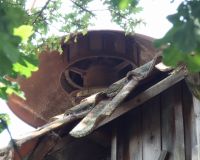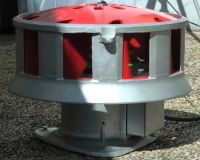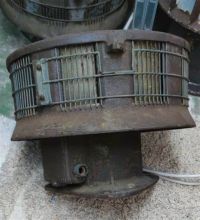L52: Difference between revisions
(Created page with "{{Infobox siren|company=<div>Elektror <div>Helin <div>Siemens <div> Rupert Rauch|type=Omnidirectional Electromechanical|produced=1941-1957|voltage=220/230/380/400|current=AC 3 ph|hp=6.7 hp|image=L141.jpg|caption=An earlier L141 unit, prior to removal.}} The '''Air Defense Siren 1952''' (German: ''Luftschutzsirene 1952'', abbreviated '''L52'''), initially named the '''Air Defense Siren 1941''' (German: ''Luftschutzsirene 1941'', abbreviated '''L141'''), was the f...") |
No edit summary |
||
| (One intermediate revision by the same user not shown) | |||
| Line 4: | Line 4: | ||
<div> Rupert Rauch|type=[[Omnidirectional]] [[Electromechanical]]|produced=1941-1957|voltage=220/230/380/400|current=AC 3 ph|hp=6.7 hp|image=L141.jpg|caption=An earlier L141 unit, prior to removal.}} | <div> Rupert Rauch|type=[[Omnidirectional]] [[Electromechanical]]|produced=1941-1957|voltage=220/230/380/400|current=AC 3 ph|hp=6.7 hp|image=L141.jpg|caption=An earlier L141 unit, prior to removal.}} | ||
The '''Air Defense Siren 1952''' (German: ''Luftschutzsirene 1952'', abbreviated '''L52'''), initially named the '''Air Defense Siren 1941''' (German: ''Luftschutzsirene 1941'', abbreviated '''L141'''), was the first German "standard siren", originally produced by Elektror and later Helin, Siemens, and Rupert Rauch. It was the predecessor of the [[E57]], and essentially paved the way for the aforementioned siren and its countless imitations. While simple, the L52 was revolutionary for its time, and was widespread throughout the 40s and 50s before ultimately being replaced by the newer | The '''Air Defense Siren 1952''' (German: ''Luftschutzsirene 1952'', abbreviated '''L52'''), initially named the '''Air Defense Siren 1941''' (German: ''Luftschutzsirene 1941'', abbreviated '''L141'''), was the first German "standard siren", originally produced by Elektror and later Helin, Siemens, and Rupert Rauch. It was the predecessor of the [[E57|Standard Siren 1957]] (German: ''Einheitssirene 1957'', abbreviated '''E57'''), and essentially paved the way for the aforementioned siren and its countless imitations. While simple, the L52 was revolutionary for its time, and was widespread throughout the 40s and 50s before ultimately being replaced by the newer E57, which offered superior performance. | ||
== History and Design == | == History and Design == | ||
| Line 12: | Line 12: | ||
Elektror immediately greenlit production of the siren, and it became a popular choice due to its simplicity and cost-effectiveness. The L141's advantageous design caught the attention of the German government, who ordered several more companies to produce a similar siren that could be rapidly installed throughout the country. The companies contracted were Helin, Siemens, and Rupert Rauch, who all produced near identical variants of the L141 with minor manufacturing differences. This further boosted the L141's popularity. Even after World War II had come to a close in 1945, the L141 continued to be produced simply because of its economic design. In 1952, Elektror renamed the original L141 the '''L52''' (some also had a "D" for ''drehstom'' (3 ph) prefix stamped on the tag, although this was redundant since all units were 3 ph); both the old L141 and newer L52 units were relatively identical, minus the L52 having the added feature of a protective grille installed around the siren's stator, which would prevent debris or any other unwanted material from entering the siren. Despite the siren's success, it was beginning to be seen as obsolete by the mid-1950s, and plans were drafted to create a similar siren which would feature several optimizations and outperform the L52. | Elektror immediately greenlit production of the siren, and it became a popular choice due to its simplicity and cost-effectiveness. The L141's advantageous design caught the attention of the German government, who ordered several more companies to produce a similar siren that could be rapidly installed throughout the country. The companies contracted were Helin, Siemens, and Rupert Rauch, who all produced near identical variants of the L141 with minor manufacturing differences. This further boosted the L141's popularity. Even after World War II had come to a close in 1945, the L141 continued to be produced simply because of its economic design. In 1952, Elektror renamed the original L141 the '''L52''' (some also had a "D" for ''drehstom'' (3 ph) prefix stamped on the tag, although this was redundant since all units were 3 ph); both the old L141 and newer L52 units were relatively identical, minus the L52 having the added feature of a protective grille installed around the siren's stator, which would prevent debris or any other unwanted material from entering the siren. Despite the siren's success, it was beginning to be seen as obsolete by the mid-1950s, and plans were drafted to create a similar siren which would feature several optimizations and outperform the L52. | ||
In 1957, the E57 was released, spelling the end for the L52. | In 1957, the E57 was released, spelling the end for the L52. This new siren carried over many design elements from the L52, with some minor changes. Most notably, the E57 utilized fiberglass reinforced plastic for the dome, with a flange at the bottom of the dome further protecting the siren from the elements. The flanges on the sides of the motor that connect it to the base of the siren were made straight on the E57, compared to the L52 where they were curved. Interestingly, unlike the L52, the E57 lacks protective conductor connections of any kind. The rotation arrow cast on the L52's motor, which displayed the correct way the rotor was supposed to spin, was moved to the flanged collar of the stator on the E57. The rotor and stator of the 2 also shared some differences; the stator of L52 units had holes drilled into them so a protective grille could be installed; on E57s, the grille is attached by 2 brackets bolted to each other, welded on each side of the siren's rotor.<ref>The brackets are also present on the L52; the only difference is the aforementioned mounting holes being absent.</ref> Furthermore, the L52's mounting holes for the dome were recessed into the top of the stator; these sat level with the stator on E57s. The motor shaft's countersink is square on the L52, whereas it is rounded on E57 units. The E57's rotor also has thicker walls than that of the L52's, likely contributing to its improved performance. | ||
The E57 was extremely popular, even more so than its predecessor, and continued on the L52's legacy. The E57 | The E57 was extremely popular, even more so than its predecessor, and continued on the L52's legacy. The E57 spawned a large number of look-a-likes and imitation sirens sold throughout other regions of Europe, all of which retained a similar style of protective dome. Despite its discontinuation, the L52's design still holds influence over the European siren market today; a wide variety of manufacturers still using the design that the L52 pioneered more than 80 years ago. Although a dwindling number of L141/L52 units remain, and few of them are active to begin with, they remain a testament to the impact they once had on the German siren market. | ||
== References == | == References == | ||
<references /> | |||
[[Category:European Sirens]] | |||
[[Category:Omnidirectional Sirens]] | |||
[[Category:Elektror Airsystems]] | |||
[[Category:Electromechanical Sirens]] | |||
[[Category:Single Toned Sirens]] | |||
Latest revision as of 18:52, 24 September 2024
| L52 | |
 An earlier L141 unit, prior to removal. | |
| Company | Elektror
Helin
Siemens
Rupert Rauch
|
|---|---|
| Produced | 1941-1957 |
| Type | Omnidirectional Electromechanical |
| Horsepower | 6.7 hp |
| Voltage | 220/230/380/400 V AC 3 ph |
The Air Defense Siren 1952 (German: Luftschutzsirene 1952, abbreviated L52), initially named the Air Defense Siren 1941 (German: Luftschutzsirene 1941, abbreviated L141), was the first German "standard siren", originally produced by Elektror and later Helin, Siemens, and Rupert Rauch. It was the predecessor of the Standard Siren 1957 (German: Einheitssirene 1957, abbreviated E57), and essentially paved the way for the aforementioned siren and its countless imitations. While simple, the L52 was revolutionary for its time, and was widespread throughout the 40s and 50s before ultimately being replaced by the newer E57, which offered superior performance.
History and Design

The L52 was introduced as the L141 by a recently graduated engineer from Berlin in 1941. It was initially pitched as a simple 9 port siren, with a 220/230/380/400 V 5 kW (6.7 hp) 3 ph electric motor underneath the stator driving the rotor at around 2800 rpm. The idea behind the L141 was to make it as inexpensive and easily mass-producible, with its conversative and simple design making it easy to manufacture in times of a metal shortage caused by the need for parts to build aircraft and other weaponry for the ongoing war. Reliability and ease of maintenance was also a key feature, with uniform spare parts that could be procured everywhere. Air was fed to the L141 beneath the rotor, rather than above it; this eliminated the need for a 2-peice shroud suspended above the stator, which was commonplace for many German sirens at the time. This saved a considerable amount of sheet steel, with the 2-peice shroud being swapped for a singular protective dome above the stator, an idea developed by a Dr. Setzepfand. This dome both shielded the siren from the elements and propagated the siren's output downwards, filling in for the role a standard 2-peice shroud would've served for cheaper.

Elektror immediately greenlit production of the siren, and it became a popular choice due to its simplicity and cost-effectiveness. The L141's advantageous design caught the attention of the German government, who ordered several more companies to produce a similar siren that could be rapidly installed throughout the country. The companies contracted were Helin, Siemens, and Rupert Rauch, who all produced near identical variants of the L141 with minor manufacturing differences. This further boosted the L141's popularity. Even after World War II had come to a close in 1945, the L141 continued to be produced simply because of its economic design. In 1952, Elektror renamed the original L141 the L52 (some also had a "D" for drehstom (3 ph) prefix stamped on the tag, although this was redundant since all units were 3 ph); both the old L141 and newer L52 units were relatively identical, minus the L52 having the added feature of a protective grille installed around the siren's stator, which would prevent debris or any other unwanted material from entering the siren. Despite the siren's success, it was beginning to be seen as obsolete by the mid-1950s, and plans were drafted to create a similar siren which would feature several optimizations and outperform the L52.
In 1957, the E57 was released, spelling the end for the L52. This new siren carried over many design elements from the L52, with some minor changes. Most notably, the E57 utilized fiberglass reinforced plastic for the dome, with a flange at the bottom of the dome further protecting the siren from the elements. The flanges on the sides of the motor that connect it to the base of the siren were made straight on the E57, compared to the L52 where they were curved. Interestingly, unlike the L52, the E57 lacks protective conductor connections of any kind. The rotation arrow cast on the L52's motor, which displayed the correct way the rotor was supposed to spin, was moved to the flanged collar of the stator on the E57. The rotor and stator of the 2 also shared some differences; the stator of L52 units had holes drilled into them so a protective grille could be installed; on E57s, the grille is attached by 2 brackets bolted to each other, welded on each side of the siren's rotor.[1] Furthermore, the L52's mounting holes for the dome were recessed into the top of the stator; these sat level with the stator on E57s. The motor shaft's countersink is square on the L52, whereas it is rounded on E57 units. The E57's rotor also has thicker walls than that of the L52's, likely contributing to its improved performance.
The E57 was extremely popular, even more so than its predecessor, and continued on the L52's legacy. The E57 spawned a large number of look-a-likes and imitation sirens sold throughout other regions of Europe, all of which retained a similar style of protective dome. Despite its discontinuation, the L52's design still holds influence over the European siren market today; a wide variety of manufacturers still using the design that the L52 pioneered more than 80 years ago. Although a dwindling number of L141/L52 units remain, and few of them are active to begin with, they remain a testament to the impact they once had on the German siren market.
References
- ↑ The brackets are also present on the L52; the only difference is the aforementioned mounting holes being absent.